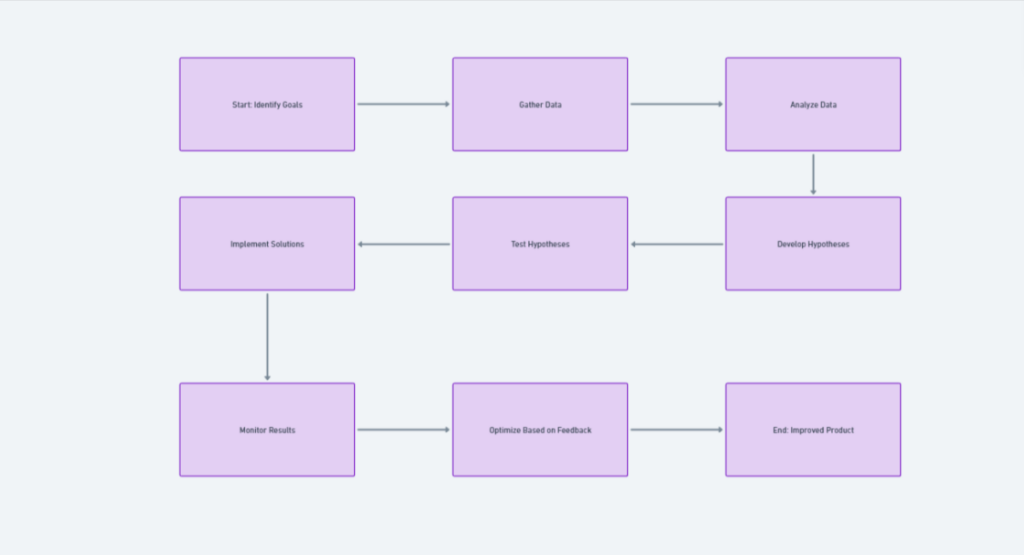Understanding how customers interact with your product is crucial for its continuous improvement and success. By analyzing product usage patterns, businesses can gain valuable insights into user behavior, identify potential areas for enhancement, and make data-driven decisions.
In today's data-centric environment, several tools are available to help organizations track and analyze how users engage with their products.
These tools offer detailed analytics that provide a deeper understanding of user interactions, preferences, and overall engagement.
Armed with this data, companies can optimize their offerings to better meet the needs of their target audience, ultimately leading to increased satisfaction and loyalty.
Leveraging Analytical Tools for Product Usage Analysis
Importance of Tracking Metrics
Tracking metrics is crucial for any business aiming to understand and improve their product performance. By collecting data on how users interact with a product, companies can identify areas that excite or deter their customer base.
Metrics such as daily active users, retention rates, and feature usage provide invaluable insights that go beyond surface-level analytics.
These metrics help pinpoint specific elements that are performing well or underperforming, allowing businesses to make data-informed decisions to enhance their strategies.
Benefits of Analyzing User Behavior
Analyzing user behavior has a multitude of benefits. Firstly, it allows businesses to create highly personalized user experiences, increasing customer satisfaction and loyalty.
Secondly, understanding user behavior helps in predicting future trends, thus enabling companies to stay ahead of the curve by making proactive adjustments to their product.
Additionally, this analysis can lead to better customer segmentation, making marketing efforts more targeted and effective, which in turn increases the return on investment.
Types of Analytics Tools Available
There are several types of analytics tools available that cater to different aspects of user behavior and product usage. These include:
- Web analytics tools, such as Google Analytics, which help in tracking website traffic and user engagement.
- Heatmaps, like Hotjar or Crazy Egg, that provide visual insights into where users click, scroll, and spend time on a page.
- Behavioral analytics tools, such as Mixpanel or Amplitude, which go deeper into understanding specific actions taken by users within the app or product.
- Customer feedback tools, like SurveyMonkey or Uservoice, that gather direct input from users about their experience and satisfaction levels.
Implementing Data-Driven Strategies for Product Optimization

Understanding User Engagement
Understanding user engagement encompasses analyzing how frequently and in what manner users interact with the product. This involves looking at metrics like session duration, frequency of use, and the pathways users take within the product.
By deeply understanding these aspects, companies can optimize features and functionalities that increase engagement or redesign elements that may be causing user frustration.
Identifying Usage Patterns
Identifying usage patterns is essential for tailoring the product to meet the needs and preferences of different user segments. This can include determining when and how often certain features are used, and recognizing patterns in user drop-offs and conversions.
Such insights allow for the optimization of user flow and the prioritization of feature enhancements to match user expectations and improve overall usability.
Improving User Experience
Improving user experience is ultimately the goal of leveraging product usage data. This involves using the insights gathered from analytics tools to make data-driven decisions that enhance usability, functionality, and aesthetic appeal.
Whether it’s simplifying navigation, increasing the responsiveness of the product, or introducing new features that users are clamoring for, every modification should aim to make the user’s interaction as enjoyable and effortless as possible.
By continuously refining the user experience based on solid data, companies can not only retain existing customers but also attract new ones.
Analyzing Data to Discover Usage Insights
Understanding user behavior and product engagement starts with robust data analysis. Proper analysis can help businesses enhance their products, tailor marketing strategies, and anticipate market trends.
Below, we delve into the primary aspects of data analytics for usage patterns.
Data Collection Methods
Effective data collection is foundational for analyzing product usage. There are multiple methods to capture data from users, which can include:
- Web Analytics Tools: Platforms like Google Analytics, Mixpanel, or Heap automatically track user interactions online, providing insights into user behavior, traffic sources, and engagement levels.
- Customer Surveys and Feedback: Direct feedback from users can be invaluable. Tools such as SurveyMonkey or Typeform help gather subjective data that is not typically captured through automated tools.
- Server Logs: For tech-based products, server logs offer detailed user activity data. These are particularly useful for understanding backend issues or user engagement at a granular level.
- Usage Monitoring Software: Software solutions that allow for the monitoring of how users interact with your software in real-time can provide valuable information for on-the-fly adjustments.
Key Metrics to Track
Tracking the right metrics is crucial to gaining meaningful insights from your data. Some essential metrics include:
- User Retention Rate: Measures the percentage of users who return to your product after their first visit.
- Average Time on Product: Indicates the total time users typically spend on your product during a visit.
- Conversion Rate: The percentage of users who achieve a predefined goal (making a purchase, signing up for a newsletter, etc.).
- Feature Usage: Identifies which features are most and least used, indicating potential improvements or changes.
- Customer Satisfaction Score (CSAT): Directly gauges user satisfaction through surveys conducted after interaction with a product or service.
Understanding these metrics can help pinpoint areas for product enhancement or user interface improvements.
Interpreting Data for Business Value
Interpreting collected data rightly steers strategic decisions and innovation. Businesses should focus on:
- Trend Analysis: Identifying long-term usage patterns to forecast future demands.
- Segmentation: Breaking down data by demographics or user behavior to tailor marketing or product development.
- Correlation Analysis: Understanding how different metrics influence each other, which can be crucial for optimizing user experience and increasing overall satisfaction.
Enhancing Product Performance with Usage Pattern Insights
Leveraging insights from user behavior and product engagement data can lead a company towards significant improvements in product performance.
By understanding what users value, companies can prioritize development efforts, resulting in a better product fit and increased user satisfaction.
- Feature Optimization: Enhance or scrap features based on user engagement and utility data.
- Personalization: Implement machine learning algorithms to deliver personalized experiences based on previous user behaviors.
- Performance Improvements: Identify and rectify performance bottlenecks that could be frustrating users and causing them to leave.
In conclusion, the use of sophisticated analytics tools and thoughtful interpretation of data not only contributes to finer product adjustments but also significantly boosts the overall business strategy.
By being attuned to these insights, businesses can ensure their products remain competitive and accurately aligned with user expectations.
Book a Demo and experience ContextQA testing tool in action with a complimentary, no-obligation session tailored to your business needs.
Conclusion
In concluding, understanding your product usage patterns through the right analytical tools can radically enhance your decision-making process and product optimization strategies.
By leveraging data analysis platforms, tracking user interactions, and applying insights from usage metrics, companies can tailor their offerings to better meet user needs and improve overall satisfaction.
Commit to integrating these tools into your regular review cycles to ensure continued growth and relevance in your market segment. Embrace analytics as your pathway to product perfection and customer satisfaction.
Also Read - What is Compliance testing (conformance testing)?
We make it easy to get started with the ContextQA tool: Start Free Trial.
